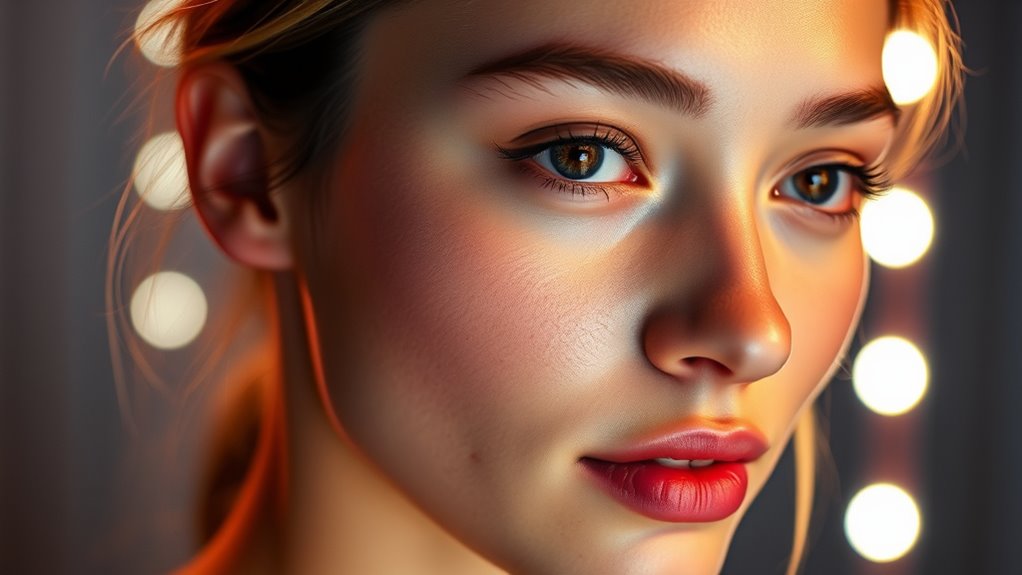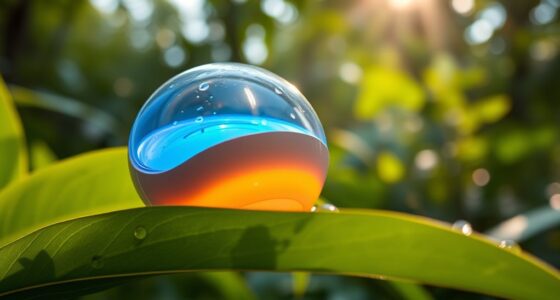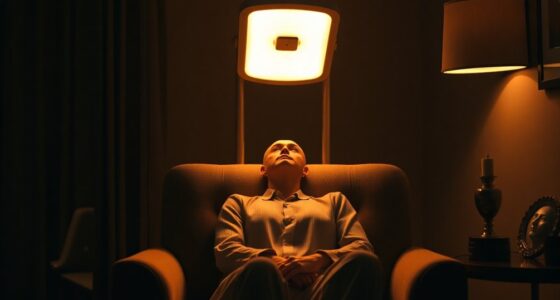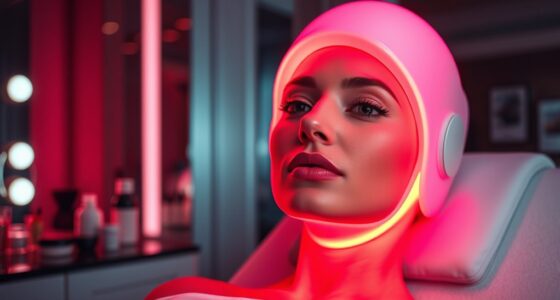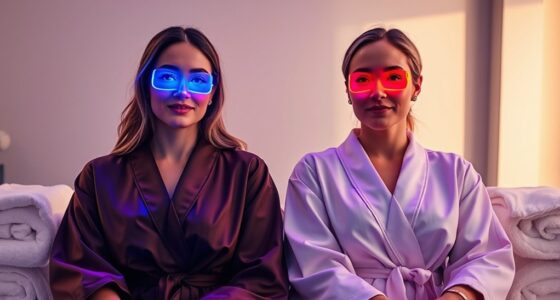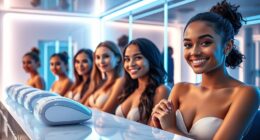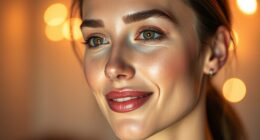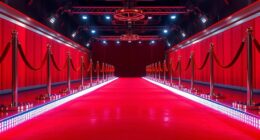Using LED lighting in selfies can considerably skew your results by creating harsh, uneven illumination that exaggerates or distorts your facial features. The intense, close-up lights cast sharp shadows, making certain areas appear more prominent while flattening others. They can also alter your skin tone with unnatural hues and cause overexposure, resulting in unflattering photos. To get a more natural look, adjusting your lighting setup can make a big difference—discover how these effects truly influence your selfies.
Key Takeaways
- LED lighting creates sharp shadows and high contrast, making facial features appear exaggerated or distorted.
- Close, intense LED lights can cause overexposure, flattening or warping facial proportions.
- Uneven illumination from LEDs emphasizes certain features, leading to unnatural or unflattering results.
- The high color temperature of LEDs can distort skin tones, giving unnatural bluish or washed-out appearances.
- Softer, diffused lighting and increased distance improve selfie authenticity by reducing skewed effects.
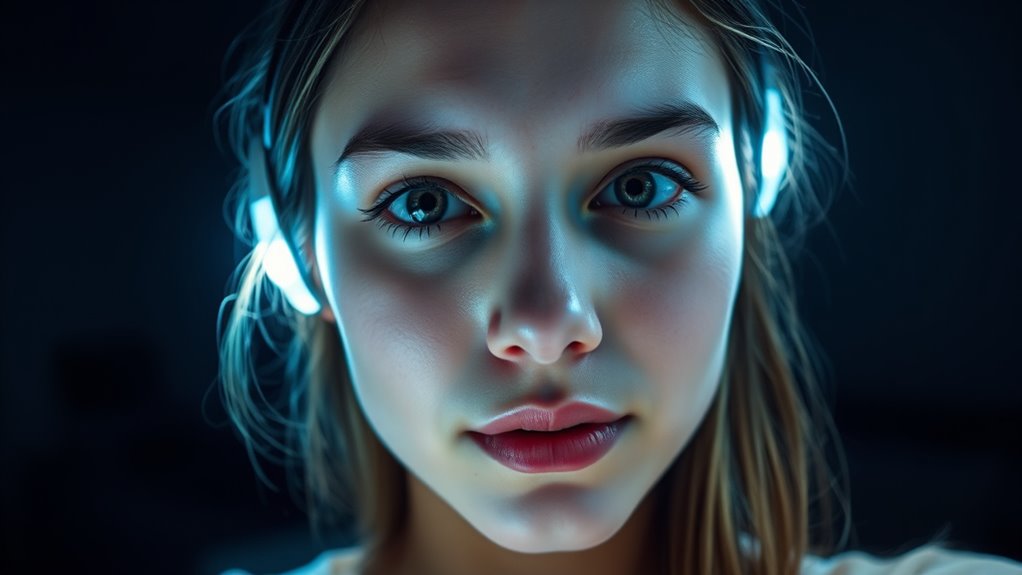
LED lighting has revolutionized the way we take selfies, but it also introduces significant distortions that can skew how you look. When you snap a photo under LED lights, you might notice your features appear sharper, smoother, or even exaggerated. This is because LED lighting, especially when it’s bright and direct, can create a range of visual effects that alter your natural appearance. Unlike natural sunlight, which tends to provide a soft, even glow, LED lights often produce harsh shadows and high contrast, emphasizing certain facial features while downplaying others.
LED lighting can distort your features, creating sharper, smoother, or exaggerated selfies.
One of the biggest issues with LED lighting is its tendency to cause unflattering distortions due to uneven illumination. When the light source is close and intense, it can cast sharp shadows on parts of your face, making features like your nose or cheekbones look more prominent than they really are. This can result in a distorted perception of your face, where some areas seem unnaturally exaggerated. Additionally, LED lights can overemphasize skin imperfections or textures, making blemishes, wrinkles, or dry patches more visible than they would be in softer lighting. Instead of a natural, flattering glow, LED lighting can produce a stark, almost clinical effect that doesn’t align with how you see yourself in the mirror.
Another way LED lighting skews your selfies is through color distortion. LEDs can emit light with a high color temperature, which often results in a bluish or unnatural hue. This color cast can make your skin look cooler or less vibrant, dulling your natural complexion. Sometimes, this effect can be so strong that it washes out your skin tone entirely, giving you a look that’s far from your true appearance. To combat this, some people use filters or adjust the white balance, but those edits can only go so far in compensating for the inherent distortions caused by LED lighting.
Furthermore, the proximity of LED lights plays a *pivotal* role. When you hold your phone close to your face with LED illumination, you risk creating overexposed spots and harsh contrast. This can flatten your facial features or distort proportions, making your face appear wider, narrower, or asymmetrical. It’s a common mistake to assume that brighter or more direct light always makes you look better; in reality, it can do the opposite. To get more natural results, it’s better to use diffused or softer lighting sources and maintain some distance between the light and your face.
Being aware of the lighting environment can significantly improve your selfie quality and authenticity. In the end, understanding how LED lighting influences your selfies helps you make smarter choices. Recognize that the way your face looks under these lights isn’t always an accurate reflection of your real appearance. Adjust your lighting setup accordingly, and don’t rely solely on bright, direct LED sources if you want a more authentic, flattering selfie.
Frequently Asked Questions
Do Different LED Colors Affect Skin Tone in Selfies?
Yes, different LED colors can affect how your skin tone appears in selfies. Warm LEDs with yellow or orange hues tend to make your skin look more radiant and warmer, while cool LEDs with blue or white tones can give a paler or more washed-out appearance. You can experiment with various lighting colors to find the one that best enhances your natural skin tone and makes your selfies look their best.
How Does Ambient Lighting Influence LED Selfie Results?
Ambient lighting can impact your LED selfies markedly, with studies showing that poor lighting can reduce photo clarity by up to 50%. When you take selfies in dim or uneven light, the LED’s brightness and color become less effective, leading to washed-out or overly shadowed images. To get the best results, make certain your environment is well-lit and evenly illuminated, so your LED lights can enhance your photo rather than distort it.
Can LED Lighting Improve or Worsen Facial Features?
LED lighting can both improve and worsen your facial features. When used correctly, it highlights your best features, smooths imperfections, and creates a flattering glow. However, harsh or uneven LED lighting can accentuate flaws, cast unflattering shadows, and distort your appearance. To get the best results, choose soft, diffused LED lights, and position them properly to enhance your natural beauty rather than distort it.
Are There Specific LED Brightness Levels That Distort Images?
Yes, certain LED brightness levels can subtly distort your images. If the light is too intense, it can wash out your features, making you appear flatter or overly shiny. Conversely, dimmer settings might not highlight your best qualities, casting shadows that obscure details. For the most flattering results, aim for a balanced brightness—enough to illuminate your face evenly without overpowering or underwhelming your natural appearance.
How Do LED Selfie Effects Vary Across Camera Brands?
You’ll notice that LED selfie effects differ across camera brands because each manufacturer uses unique algorithms and lighting settings. Some brands enhance brightness and smoothness, while others aim for more natural tones. You might find that certain brands’ LEDs produce cooler or warmer effects, influencing how your skin looks. To get the best results, experiment with different brands and settings, and always check how the lighting affects your overall image quality.
Conclusion
Next time you snap a selfie with LED lighting, remember it can dramatically change how you look. Studies show that lighting can alter perceived skin tone and facial features, sometimes by as much as 20%. So, don’t rely solely on your camera’s filters—be mindful of how lighting influences your photo’s outcome. By understanding this, you can better control your selfies and showcase your true self, no matter the glow.
